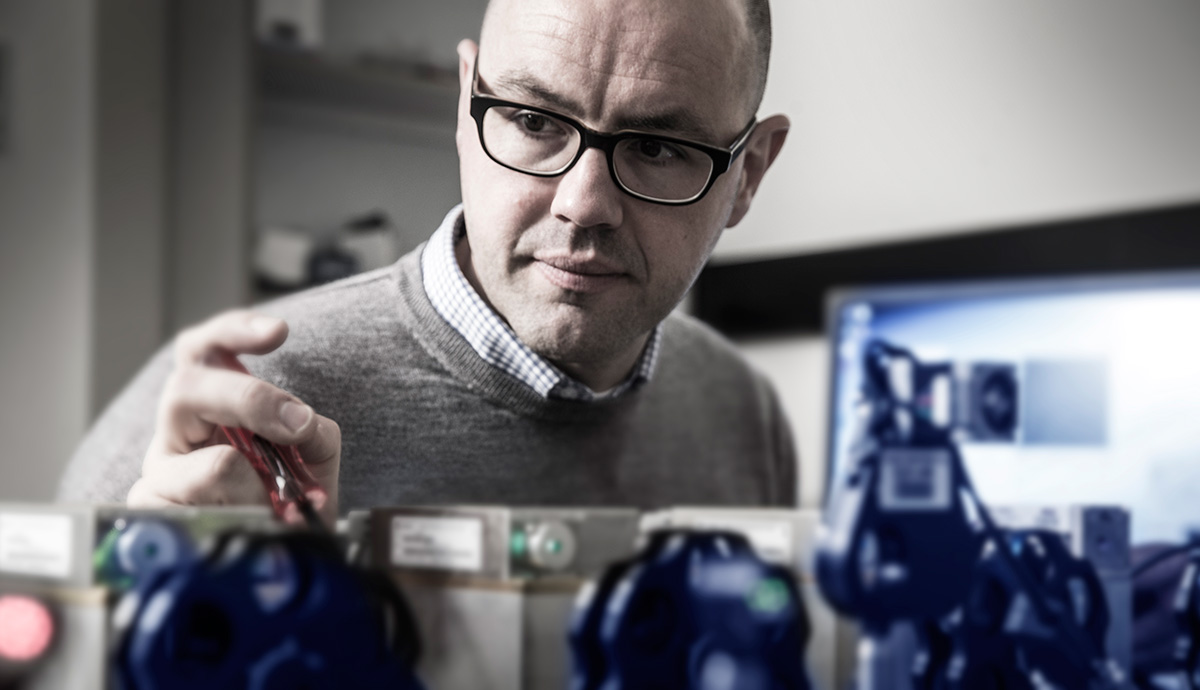July 27, 2015
Molecular movies unlock the secret life of DNA
A new way to study cells in order to understand disease and help develop new drugs is being pioneered at UOW.
World-renowned biophysicist Professor Antoine van Oijen, from the School of Chemistry, is building powerful new microscopes with lasers and ultrasensitive cameras that can capture one of the processes fundamental to life: the copying of DNA.
Cells need to copy their DNA in order to divide and multiply. This process is called DNA replication.
It is hoped that taking a closer look at how individual proteins, the ‘housekeepers’ of the cell coordinate thousands of specialised tasks at the microscopic level, will aid better understanding of what goes wrong on the molecular and cellular level when people develop disease.
“Seeing is believing. What we are trying to do here is to build microscopes to directly observe, to directly visualise how individual proteins copy DNA molecules,” Professor van Oijen said.
“So by making real-time ‘molecular movies’ of the proteins responsible for copying and repairing DNA, we will be able to see, quite literally, how these processes work, and how they can cause disease when they stop working.”
Many diseases, from congenital conditions like fragile X syndrome and certain autism-related disorders, to diseases that start later in life, such as Huntington’s and certain types of cancer, are born from problems during DNA replication.
While DNA replication is an extremely accurate process, errors still occur when its sheer complexity is considered: more than five trillion cell divisions are required for a fertilised egg to develop into an adult human, not to mention the tens of billions of cell divisions that happen every day in adults to maintain health.
Professor van Oijen, an Australian Laureate Fellow, is one of 12 recently promoted and appointed professors who will be sharing their research with the public and industry at the second UOW Big Ideas Festival on 25 August.
Since he began at UOW in January 2015, Professor van Oijen and his multi-disciplinary team of physicists, chemists and biologists have started using the techniques they have invented to better understand the replication process. They are also working on the development of new approaches to discover drug against viral infections.
“We are creating a novel way to observe the process by which a virus merges its membrane to the lipid bilayer enveloping living cells. This method allows us to rapidly screen the effects new drug candidates have on this important step in the infection pathway.”
He has also started working closely with researchers in the Illawarra Health and Medical Research Institute based Proteostasis and Disease Research Centre who are making significant discoveries on the link between protein homeostasis dysfunction and neurodegenerative diseases such as Alzheimer’s disease.
His DNA replication work is part of a five-year, $2.9 million Australian Research Council Australian Laureate Fellowship awarded to Professor van Oijen in 2014 to place Australia at the forefront of single-molecule DNA research.
“In the past 10-15 years, we have made an amazing amount of progress in the field. At the moment, my team is trying to understand the mechanism for DNA replication, just like an engineer would understand how a car works.”
“We want to provide the information that creates understanding of disease processes and that in the end allows doctors to cure people from a range of devastating diseases.”
The Big Ideas Festival will be held on Tuesday 25 August from 5pm to 9pm at the UOW University Hall. Register to attend this free event.
Professor Antoine van Oijen biography
Professor van Oijen graduated with a PhD in Physics from the University of Leiden in the Netherlands and completed a postdoctoral fellowship at Harvard to develop his knowledge in biological applications of single-molecule techniques. He was the first in his field to establish a biomedical research group at Harvard Medical School with a single-molecule biology laboratory. Moving to the University of Groningen, he developed a single-molecule microscope facility now used by more than 10 research groups. Recently he moved to UOW, after an 11-year collaboration with UOW’s Professor Nick Dixon, and was awarded a prestigious Laureate Fellowship by the Australian Research Council to further develop biophysical approaches to visualise the molecular processes that define life.
